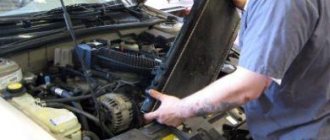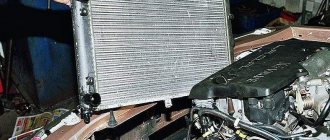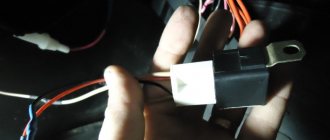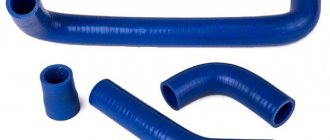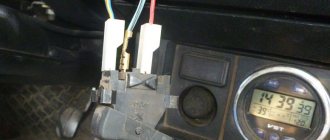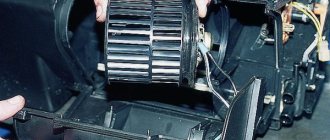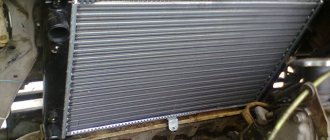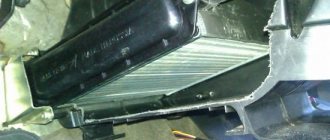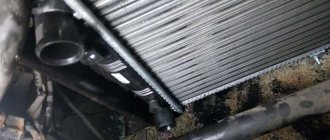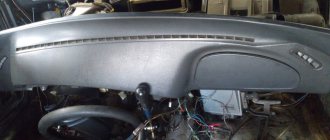It is no secret that a car radiator is one of the most important automotive parts in the vehicle engine cooling system. Its main purpose is the timely removal of heat from the internal combustion engine into the atmosphere. This occurs due to the circulation of liquid through channels, of which there are quite a lot in the car’s heat exchanger. Thus, the article describes relevant decisions for car owners on how to solder a car radiator, and what equipment should be prepared for these purposes.
- Car radiator repair methods
- How to seal a car radiator?
- Assessing the extent of radiator damage
- Internal radiator repair using chemicals
- How to solder plastic car radiator
- Surface preparation
- Preparing the adhesive mixture
- Cold welding
- Final stage
- DIY aluminum car radiator repair
- Security measures
- conclusions
Every driver should understand that the key factor for the correct functioning of the cooling system is its tightness. This means that even the smallest and most unnoticeable crack will completely disable it. Before working on soldering the part, it is important to study the process of repairing an engine cooling radiator with your own hands, and also determine which glue should be used in each specific case.
Is repair always possible?
A radiator leak detected early is easier to repair because the cause of the failure is a small crack. A defect identified in time is easier to eliminate, and the restored device will last for many more years.
To reinforce the adhesive layer, it is possible to use simple plastic mesh Source Samsvar.ru
Basic methods for eliminating leaks
Before starting repair work, you should decide on the restoration method. Most often, damage is eliminated using:
- gluing. This method is chosen to eliminate minor cracks. To successfully solve the problem, pay attention to the composition of the glue: the substance must be selected according to the material of which the radiator body is made;
- cold welding. The adhesive mass contains epoxy resin and additives in the form of iron and other compounds. Repairs using cold welding occur efficiently and quickly. Despite the ease of use, a leak can be eliminated in a short time by forming a reliable seam at the crack site.
Assessing the extent of radiator damage
It is customary to install the radiator itself in the engine compartment, or rather in its front part. This is how it is possible to create the effect of blowing with a counter flow of air while the vehicle is moving. The disadvantage of a car heat exchanger is its fragility. This device is often called the most vulnerable part of any car.
Even if the slightest impact occurs, the likelihood of mechanical damage to the spare part in question is quite high. Heat exchangers whose water tanks are made of plastic break down especially often. Therefore, when deciding how to repair a radiator, you need to focus primarily on your capabilities. Carefully study all the methods presented above and try to figure out which method will be the most convenient and simplest from a practical point of view.
It is also important to first assess the extent of the damage. If it is strong enough, it is recommended to focus on direct adhesion. This way you can deal with really large cracks that cannot be fixed with ordinary glue. If the crack is not the largest, cold welding type putty is quite suitable. Glue will be the optimal solution for restoring small cracks.
If you are not sure that you know how to seal a car’s cooling system, it is better to focus on repairing the system at a car service center. In addition, you won’t have to spend too much money on restoration work carried out by a mechanic, because the process itself is not considered difficult.
Application of glue
Only two-component adhesive mixtures are suitable for repairing a plastic radiator. They cope well with situations where the crack in the radiator is large enough or it is not possible to connect the parts of the case due to a lack of small fragments. If a small crack is being repaired, simply mix the glue components and apply it to the crack in two layers.
In some cases, a crack appears in a hard-to-reach place. In this case, the sealant is applied along the entire length of the radiator Source Chebo.pro
The history of the creation of a car radiator, as well as its development and evolution
During the development of the automotive industry, many new components appeared. But some details were present in the design of “self-propelled carts” almost from the beginning of their operation. One of these components is a car radiator, the history of which dates back to the end of the 19th and beginning of the 20th centuries.
Coils
As long as the engines were of low power, excess heat was dissipated directly from the engine and its components. With an increase in power, the first radiators began to be used - in the form of a smooth-walled copper pipe, bent in the form of a coil. In 1900, external fins for this coil were used.
Honeycomb radiators
In 1913, the first plate brazed copper-brass radiator appeared. In parallel, a radiator design appeared in which the air passed through horizontal air tubes inside the tank; the number of these tubes grew larger over time until a honeycomb radiator was created, which was common until the mid-30s.
Tubular-plate and tubular-tape radiators
Honeycomb radiators are quite labor-intensive to produce, bulky and heavy. The main incentive for the development of automotive heat exchangers - an increase in engine power and a reduction in engine compartment space - forced the development of more complex designs. Radiators have brass bottoms where copper tubes surrounded by steel plates are sealed (tubular-plate copper-steel radiators). Due to the use of steel plates in the production of tubular-plate radiators, many disadvantages of this design arise - high weight, minimal heat transfer rates, low corrosion resistance of the core, low vibration resistance.
In their further development, such radiators receive copper tape instead of steel plates (tubular-plate copper-steel radiators), which can significantly increase their heat transfer. Such a radiator weighs much less with a significant improvement in thermal performance.
Prefabricated aluminum radiators
Prefabricated aluminum radiators began to be developed in the USSR during the Cold War. Since copper was a strategic raw material, researchers began to try to create aluminum radiators of brazed and prefabricated construction. Prefabricated radiators have lower heat output, but are cheaper to manufacture.
The first attempts to create aluminum prefabricated radiators were made at the Mariupol (Zhdanovsky) radiator plant for the ZiS-120 car, but they were not very successful, since the design with flat-oval tubes was taken as a basis. The flat-oval tubes were incredibly difficult to seal at the ends where they met the bottoms, making the project very expensive and soon abandoned. About 2 thousand radiators of this type were made.
Brazed non-assembled aluminum radiators
The first steps towards the most modern heat exchangers - aluminum brazed radiators - were made in the 70s of the 20th century. The first radiators of this design were originally developed for GAZ 3102 cars. Unfortunately, the first experiment was unsuccessful - the brazed aluminum radiator could not cope with heat transfer, especially in urban mode, and therefore was soon replaced by a copper-brass one. However, the reason for its poor heat transfer was the design of the aluminum tape - its pitch was approximately 8mm. The reason for such a large-cell core design is trivial - at the plant that produced these radiators, there was no technological opportunity to make a smaller pitch of the cooling tape.
Interesting developments in the field of car radiators
The entire development of automotive heat exchangers has strived to increase heat transfer while maintaining dimensions and simultaneously reducing cost. The pace of development of automobile radiators was determined by the rapid pace of development of automobile engines - engine power grew very quickly, and it became increasingly difficult to cool it.
In attempts to achieve results, various interesting types of radiators were created, which for some reason were not included in the series. The most interesting samples are presented below:
Automotive radiator
Of interest is the method of securing the tank lids - using bolts. This radiator is repairable, which is especially important for rural areas.
“Waste-free” aluminum radiator
Developed by V.V. Burkov. for the KamAZ vehicle. It is a rather original design; Instead of cooling plates, aluminum production waste (actually sawdust) was used. Such a radiator turned out to be quite difficult to manufacture and therefore did not become widespread.
Aluminum Brazed Heater Core
Used for LiAZ buses. This radiator is of particular interest due to the use of removable radiator pipes. This decision was most likely made to unify the product - given the impossibility of accurately specifying the angle at which the pipes need to be fixed, a variable angle is required.
Aluminum Assembled Flat Oval Tube Cooling Radiator
Designed for PORSCHE cars. While the traditional aluminum prefabricated radiator has round cooling tubes, the flat oval tube radiator takes us back to the first attempts at a prefabricated radiator. Why create a radiator with flat oval tubes? The contact area of the incoming air flow with such a tube is 30% larger than with a round one - accordingly, the heat transfer is greater.
Combined cooling and heating radiators
When creating such radiators, combinations of traditional materials were used - copper, brass, aluminum, steel. The most striking example is a prefabricated radiator with round aluminum cooling tubes and copper plates.
Improving the design of Luzar car radiators
The development of automotive heat exchangers does not stop. The emergence of new types of radiators, which have their own advantages and disadvantages, is accompanied by numerous and sometimes unnoticeable design improvements, which are of great importance for increasing the efficiency of a given vehicle component.
We invite you to familiarize yourself with some of the innovations developed and introduced into the production of Luzar automobile radiators.
Improving heat transfer is the use of plastic turbulators inside the radiator.
This design improvement made it possible to improve heat transfer performance. The turbulator creates turbulence in the flow of coolant in the radiator - due to this, the liquid releases heat faster.
Universal radiators - use a heat-resistant sealed plug at the location where the fan switch sensor is mounted.
Cars of the LADA Samara and LADA Ten family with a carburetor engine are equipped with a fan activation sensor, for which a threaded hole is provided in the radiator tank. Cars of this family with an injection engine are not equipped with a fan switch sensor. The cooling radiator for this engine modification does not have a hole for the sensor.
In addition, VAZ-2105 cars have a forced constant fan drive (the fan does not have an electric motor and rotates along with the crankshaft speed) - the sensor is also not used in radiators on such cars. A similar radiator for VAZ-2104 and VAZ-2107 cars has an electric fan; The radiator for such a car requires the installation of a fan switch sensor.
The use of a heat-resistant plug at the sensor mounting location made it possible to unify six models of radiators.
Universal radiators - double mounting points for the radiator deflector (casing)
These radiators have universal mounting points for the fan deflector (casing), suitable for VAZ-2105 and VAZ-2107 modifications. For VAZ-2105 cars, the upper and lower mounting points of the radiator deflector (casing) are used; for VAZ-2107 and VAZ-2104 cars – the middle location for attaching the deflector.
Both aluminum and copper-brass radiators Luzar received this improvement.
Universal radiators - use a heat-resistant sealed plug at the mounting locations of the fan switch sensor and overheating sensor. Used on aluminum and copper-brass radiators for Volga and GAZelle cars - they unify the use of such a radiator on cars with ZMZ-402 and ZMZ-406 engines.
Cold welding
This epoxy resin-based adhesive is excellent for repairing any plastic parts - just apply the adhesive and wait until it dries completely. Cold welding can also be used as an additional protective layer over a patch of regular two-part adhesive.
To eliminate a leak at the junction of the pipe, it is best to use cold welding Source B2b-instrument.ru
Security measures
When repairing a car radiator, you should be extremely careful and follow certain safety measures. The heat exchanger itself must be disconnected. Drain all liquid completely.
If you have not previously had experience working with a soldering iron, it is better to entrust this task to professionals. In this case, you should at least practice on less important surfaces and parts of the car.
When working with cold welding or glue, it is important to use gloves to avoid damaging your hands. In addition, be sure to follow the instructions for using the glue. This way you can not only achieve the ideal effect of the repair, but also protect your hands from the harmful effects of adhesives.
conclusions
So, following the recommendations and advice in the article, determining what to seal a car radiator with will not be difficult. The main thing is to follow some safety measures and choose the best repair option. If you are not sure that you can cope with such a task on your own, it is better not to take risks and seek help from qualified auto mechanics.
Still have any questions? In this case, we recommend watching a video on how to repair a car radiator at home. We wish you good luck in your endeavor!
Internal radiator repair using chemicals
There are special compounds on sale that can be used to restore the tightness of the radiator without extra effort. This chemical is a powder poured inside the radiator. Under the influence of water and high temperature, the particles of the composition swell and seal minor cracks in the body. In auto shops, this product is known as “powdered radiator restorer.”
Appearance of a sealing patch made from two-component adhesive Source Drive2.ru

